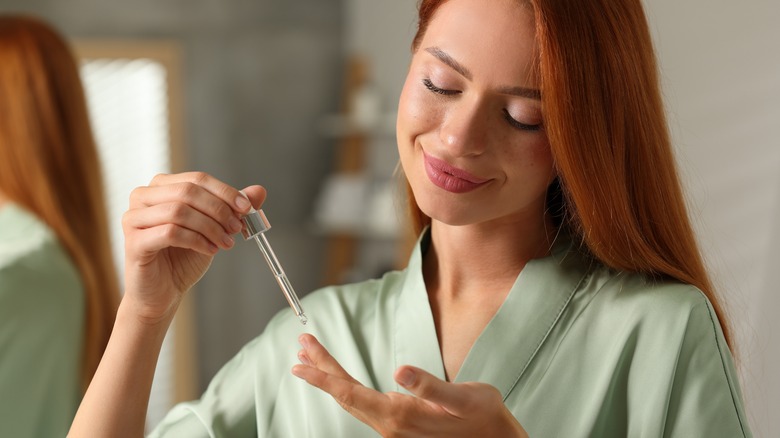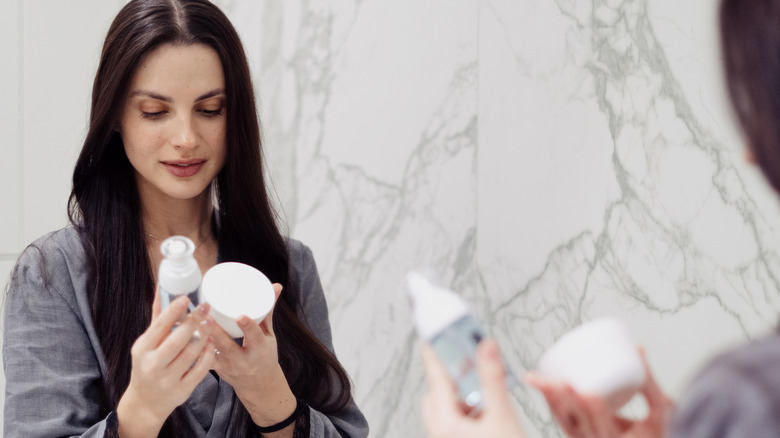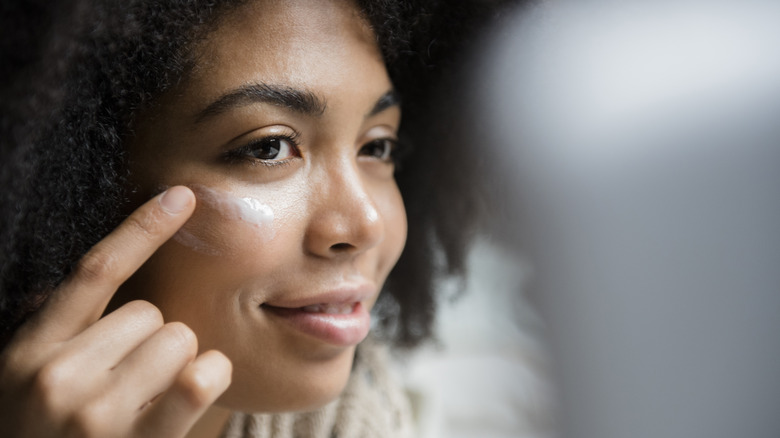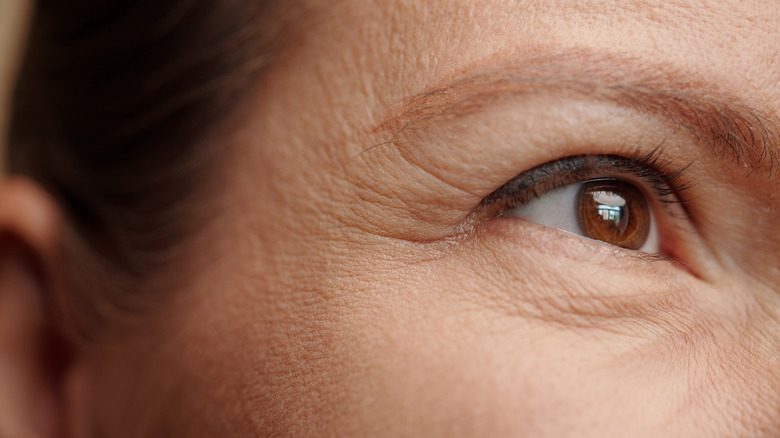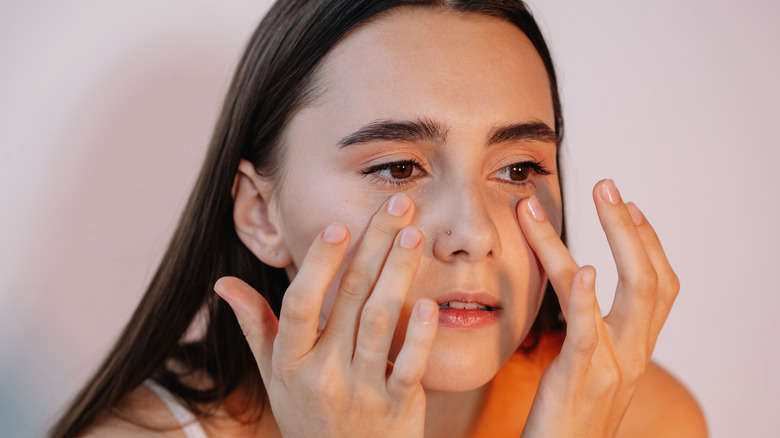Eye Serum Mistakes You Want To Avoid, According To Our Dermatologist
Face serums and ampoules will do wonders for your skin's complexion, including keeping your skin plump, radiant, and hydrated. Eye serums work similarly to treat the delicate skin around your eyes. Unlike an eye cream, a serum delivers more concentrated ingredients to your under-eye area, among other things, which you can use to get rid of dark under-eye circles, puffiness, hyperpigmentation, and wrinkles. That said, many people don't understand the correct way to incorporate an eye serum into their skincare routine, leading them to believe that eye serums aren't effective enough on their own to treat their skin concerns. Therefore, knowing how to use an eye serum correctly is important to getting good results.
According to double-board certified dermatologist Dr. Brendan Camp of MDCS Dermatology, there are five common mistakes people make when it comes to eye serums that prevent them from receiving the results for which they're hoping. This includes anything from applying the wrong amount to using eye products at the wrong time of day. By following Camp's expert tips that are exclusive to Glam, it's easy to learn the right way to use an eye serum and finally make the most of your eye routine.
Using the wrong amount of product
As the saying goes, "A little goes a long way," and this applies to your skincare routine, especially when it comes to eye serum. Many people assume the more serum you use, the greater the benefit. However, this is usually not the case, at all. In fact, slathering on large amounts of serum or cream can create a whole slew of problems, such as skin irritation and clogged pores. If that's somehow not reason enough for you to rein in your serum use, here's a reminder that unnecessarily applying too much product also puts a large dent in your wallet, and no one wants that.
Thankfully, Dr. Brendan Camp knows the right way to use your eye serum. "Apply a thin layer of the eye serum to the treatment area. Excessive application can cause skin irritation or risk clogging pores, which can contribute to acne formation," he tells Glam exclusively. A thin layer of serum around the eyes helps the ingredients absorb into the skin without smothering it. An easy way to control how much serum you use is to pour a pea-sized amount of serum directly onto the tips of your fingers before applying it under your eyes. This also ensures the dropper does not touch your skin, as if it did, it could encourage the spread of acne-causing bacteria.
Not understanding the ingredients
Shopping for eye serums can seem daunting if you don't know what to look for, and all the different brands and ingredient lists only add to the confusion. However, as soon as you identify your target issue, the process becomes much less stressful. For instance, if you're tired of dry skin around your eyes and want to try a simple serum to get started, choose a serum formulated with hydrating ingredients, such as hyaluronic acid, which restores moisture and elasticity to the skin.
However, if you're on the hunt for a multi-purpose eye cream, "look for eye serums that contain retinol or vitamin C," Dr. Brendan Camp tells Glam exclusively. "These are ingredients with well-established findings that support their ability to contribute to collagen production and limit the appearance of fine lines and wrinkles." Both retinol and vitamin C stimulate collagen production to prevent signs of aging, while the antioxidant benefits of vitamin C also help reduce hyperpigmentation and dark circles. However, there are certain precautions to take when using an eye serum with retinol. "Use retinol-containing eye serums at night," Camp says. "Retinols can make skin sun-sensitive and are best tolerated when applied at night."
Not factoring in sun exposure
Neglecting the under-eye area while applying your daily sunscreen is a big no-no among skincare experts for multiple reasons. For one, the skin around your eyes is much more delicate than the rest of your face and, therefore, vulnerable to sun damage — one of the leading causes of premature aging. "If you are not using an eye serum in the morning that contains an SPF, apply an SPF moisturizer to the skin around the eyes as a final step to your skincare routine," says dermatologist Dr. Brendan Camp during an exclusive interview with Glam. "Sunscreens limit the damaging effects of UV radiation on the skin." This will prevent early signs of aging, such as wrinkles, along with hyperpigmentation and sun spots.
Moreover, most sunscreens are safe to use around your eyes, but chemical sunscreens sometimes contain harsh ingredients that may irritate the thin skin in that area. For this reason, those with sensitive skin find better luck with mineral sunscreens to reduce the chance of a reaction — and the same goes for an SPF moisturizer. If you experience any redness, breakouts, or irritation after applying sunscreen or an SPF moisturizer, stop using it as you may be allergic to one of the ingredients, and consider talking to a doctor if the reaction warrants it.
Only applying serum to the under-eye area
According to Dr. Brendan Camp, one of the top mistakes to avoid when using an eye serum is ignoring the key areas. "Don't focus only on the undereye area," Camp shares with Glam in an exclusive. "Remember that crow's feet appear on the side of the eyes, which should also be treated with eye serums." Crow's feet, or lateral canthal lines, are deep wrinkles that form in the corners of your eyes. For instance, even simple repetitive movements such as smiling or squinting will cause the skin to crease.
Factors such as genetics, lifestyle, and sun exposure affect how early or severe these lines will appear. However, as you age, fine lines and wrinkles naturally become more prominent due to the gradual decline of elasticity. As such, paying special attention to both the under-eye area and the sides of your eyes will help reduce the appearance of fine lines. Serums are considered more lightweight than rich under-eye creams, but if you are prone to milia around the eye orbit region, check the ingredients for heavy ingredients that may clog your skin.
Not applying eye serum consistently
As with any other skincare product, it takes time for the ingredients to take effect. "Be consistent with the use of eye serums, or any skincare product for that matter," Dr. Brendan Camp advises Glam in an exclusive. "Regular, consistent use of an eye serum will deliver better results than haphazard application of a product." In other words, applying a drop of eye serum here or there isn't likely to erase your fine lines. Instead, stick with your serum before you abandon your eye care routine after several weeks.
The time it takes to notice results depends on several factors, including your consistency of application, the ingredients, and the severity of your target concern. Applying a serum to deep lines or wrinkles may not remove them entirely. However, using serum as a preventative measure can help prevent them from forming down the road. Ultimately, eye serums are worth the time and effort if you're concerned about fine lines or dehydration around the under-eye area, but they're often a long-term investment rather than an immediate solution. They require diligent application and, most of all, patience.

